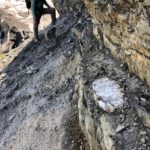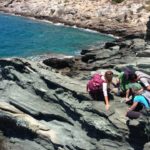Subduction Interface Dynamics from Shallow to Deep Projects
Modern subduction zones play a key role in large-scale Earth process, including mass and volatile recycling, plate boundary deformation, and seismicity. Evidence from the rock record of ancient subduction zones can complement geophysical investigations of modern systems by informing our interpretations and providing constraints for geodynamical models. We particularly focus on how deformation in the interface between the overriding and downgoing plate affects larger subduction zone process such as changes in seismic style, interplate coupling, plate speed, and upper plate topography. Our research aims to address the questions: what mechanisms accommodate strain in the subduction interface, to what extent does that deformation affect large-scale subduction zone processes, and what signature might the interface have in current geophysical data?
Deformation in subduction zones changes dramatically both down-dip and along-strike due to changes in P-T conditions with depth and variations in incoming lithologies, thermal structure, and overriding plate characteristics along strike. To tackle the downdip evolution of a subduction zone, we are investigating subduction complexes exhumed from the shallow, intermediate, and deep subduction interface. For these projects, we use a combination of field investigations, structural geology, geothermometers/barometers, assorted geochronometers, microstructural techniques, and modelling to characterize the geologic history, rheology, and impact on subduction zone processes.
4D rheological evolution of the subduction interface
Shallow interface: Chugach Complex, Alaska, USA

Very low frequency earthquakes are observed up-dip of the subduction megathrust in well-instrumented modern subduction zones. The Chugach Complex in Alaska exhibits complicated deformation across a range of juxtaposed lithologies that can provide insight into processes that generate these shallow, low frequency earthquakes. We just began field work in the Chugach in summer 2018 and are excited to begin digging into the geology of this area.
Team Members & Collaborators: Whitney Behr, Mark Helper
Intermediate interface: Condrey Mountain Window, northern California, USA

Exhumed from just downdip of the subduction megathrust, the Condrey Mountain Window units represent the transition from the source of megathrust earthquakes to more distributed deformation observed in Syros and associated with Episodic Tremor and Slow Slip (ETS) events. By capturing this transitional zone, the Condrey Mountain Window units provide key insights into down-dip changes in rheology and associated geophysical signatures.
Team Members & Collaborators: Carolyn Tewksbury-Christle, Whitney Behr, Mark Helper
Deep interface: Syros Island, Greece

In modern subduction zones, the interface near the mantle wedge corner is characterized by complex seismicity (e.g., Episodic Tremor and Slow Slip, low frequency earthquakes, non-volcanic tremor). The rocks on Syros Island show evidence of distributed, block-in-matrix style deformation. Patchy dehydration from blueschist to eclogite forms strong, brittle, eclogitic blocks in a ductily deforming blueschist matrix. Brittle failure of these rheologically strong blocks is consistent with observations of deep tremor in modern subduction zones. Characterization of the deformation mechanisms in the blueschist matrix also puts constraints on bulk rheology of the subduction interface that can be implemented in geodynamical models.
Team Members & Collaborators: Alissa Kotowski, Whitney Behr, Kyle Ashley, Jaime Barnes, Miguel Cisneros, Daniel Stockli, Kostis Soukis
Publications: Behr, Kotowski, & Ashley, Geology (2018)
Sediment control on subduction plate speeds
Plate speeds are governed by a balance between driving (density contrasts) and resisting (mantle viscosity, plate bending, interplate coupling) forces. In geodynamical modeling, the subduction interface is generally assumed to be very low-viscosity, allowing for full decoupling between the overriding and downgoing plate. Accounting for changes in the material along the subduction interface, however, significantly affects the interface viscosity and downgoing plate speed. Calculations based on energy balance equations (Behr & Becker, 2018) suggest that sediment lubrication along the deep subduction interface can play a key role in plate speed. We are continuing to quantify the effect of plate interface viscosity controlled by lithology and progressive metamorphism through more robust geodynamical modeling software.
Team Members & Collaborators: Whitney Behr, Thorsten Becker, Adam Holt, Carolyn Tewksbury-Christle
Publications: Behr & Becker, EPSL (2018)












